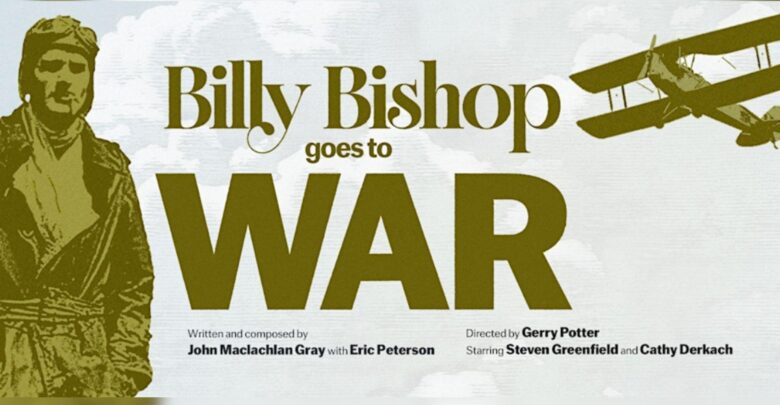Play Review: ‘Billy Bishop Goes to War’
If you were given the choice to give up anything to become a national hero, what would you choose? For Billy Bishop, it was his innocence.
 Supplied
SuppliedFrom October 24 to November 8, the Edmonton Repertory Theatre ran a two-man performance of Billy Bishop Goes to War. This play, being a Canadian stage classic, recounts the experience of First World War fighter pilot Billy Bishop. The performance, told through story-like monologue and humorous song and dance, follows his journey from being a troubled student to a war hero. And Steven Greenfield and Cathy Derkach immersed their audience into a story of Canada’s participation in the First World War with only a handful of props. This performance of Billy Bishop takes its audience through the trenches, into the air, and to the many places between. It was brilliant!
The set up was simple yet effective: a piano to the left, and a stack of chest boxes to the right. At the centre was a large canvas painting of no man’s land, and Bishop’s yellow plane. Toward the front, a single chair, and that was all. The play began with Greenfield embodying the careless and naïve Billy Bishop as a military cadet, amused by his own trickster behaviour and academic inadequacies. Derkach’s work on the piano added structure to the narrative, emphasizing moments of unseriousness with whimsical notes. And other times, contrasted this with deep and daunting tones during moments of action and realization.
As the play progresses, there is a “growing up” of the carefree Billy Bishop as his outlook of the war becomes increasingly pessimistic. He is exposed to greater casualties and wishes to return to his peaceful homeland of Canada. In efforts to escape the madness that characterized his time in the cavalry, Bishop enlists to become a fighter pilot. And against his odds, he makes his way into the air!
The unspoken communication between the two performers was remarkable to watch. Quick moments of eye contact, and attentive listening to cues really revealed the chemistry between Greenfield and Derkach. Through exaggerated changes in accent and body language, performers embodied numerous supporting characters throughout the story. And despite the number of character changes, both actors maintained constant communication.
The range shown by Greenfield in his portrayal of an Irish patron, a British Royal, and a French performer was not only believable, but pleasurable and entertaining to watch. There was never a moment during the performance that I felt disconnected from the narrative. Both Greenfield and Derkach remained engaged with the audience for the entirety of their performance. Stares and gestures at audience members made it feel like we too were part of the play. It created an atmosphere of shared storytelling.
These moments demanded the attention of the audience, ensuring that what was being said was also being felt. And some of these moments were intense in the best of ways. During moments of longing, Greenfield made us feel like we were part of Bishop’s thoughts — like his second conscious, also trying to solve his unease.
Sound effects were vital to the storytelling of this play, and surprisingly, these effects were all created live by the performers. Banging on the top of the piano emphasized the stomping of Bishop’s military sergeant, and buzzing of the mouth signaled the intensity of the gun shots during battle. Greenfield and Derkach successfully achieved strong dynamics in their performances, capturing emotion with sound and movement. Battle scenes were not only captivating, but also immersive. Every scene added a layer of depth to the next.
In one scene, Bishop lands his yellow plane near the British frontlines. After a glorifying successful air battle, Bishop spends the night in the trenches. Upon waking, he sees his plane, too, had survived the rage. But in no man’s land, previous soldiers did not meet the same fortunes. This scene, echoed by somber musical tones and slow pacing, contrasted heavily to the previous. It was truly capturing the duality of war, especially at the frontlines.
Lighting and colour also emphasized the emotional aspects of the play. Blue and white coloured lights were used during times of introspection. Reds were used during times of rage and love. The supporting details of this performance undoubtedly showcased the time and effort put into its preparation. It is no wonder this play is a Canadian classic.
The shift in narrative before and after the intermission was significant to the overall messaging of the play. By the end of the play, we encounter a completely different Bishop. More sincere in his speech, and empathetic to the youth preparing to depart for the Second World War. Bishop finds himself wondering “what it was all for?” and having no answer. This moment of defeat, faced in hope, was met with a long silence from both Bishop and the members of the audience.
The performance of Billy Bishop Goes to War not only provides insights into the experiences of Canadian soldiers during the First World War, but also demonstrates one’s ability to persevere against all odds. Leaving the performance, I was left with greater love for Bishop than I had expected. The loss of our innocence is something everyone experiences in this lifetime. But the loss of innocence through war is one that truly no one deserves to experience, and yet so many had, and so many still do. While performances tend to remind its audience of our shared humanity, this performance truly captured the pain of living in a world at war.




